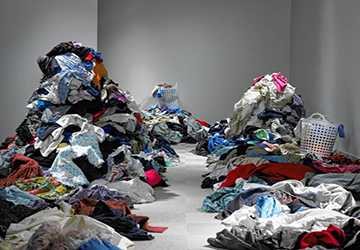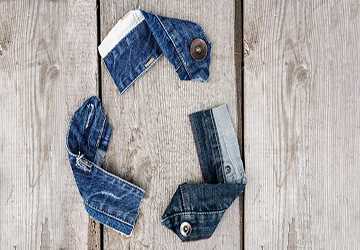What You Should Know About Fashion Recycling
Grasping the Core of Fashion Upcycling
In today's eco-conscious world, the core of fashion recycling basics is transforming previously loved apparel into fresh, fashionable pieces. This transformative process may range from taking apart a garment to harvest its cloth for a fresh design to decomposing the fabric into its original fibres, ready to be woven into new threads. The essence of fashion recycling transcends beyond just reusing materials; it's about reimagining the fashion lifecycle, turning what was once old into the new chic.

Fundamental Steps in Fashion Recycling
The fundamental steps in fashion recycling basics are intuitive yet impactful. They involve carefully evaluating clothing, rejuvenating, and sanitizing them, and finally determining the greenest method to re-enter them into the fashion stream. This practice is often showcased in second-hand stores and niche shops that feature retro and reworked attire.
l Examining clothing to gauge its suitability for renewal
l Mending garments that are salvageable
l Sanitizing textiles for safe Reutilization
l Innovatively crafting old fabrics into new masterpieces
The Vital Role of Recycling in Fashion Evolution
Underlining the importance of fashion recycling is akin to highlighting a vital component of sustainable living. It's a pivotal activity significantly reduces the fashion sector's ecological footprint. Stepping back from new material production decreases environmental degradation. Recycling brings new life into materials, sparing them from becoming part of growing landfill mountains.
l Diminishes waste, conserving space that landfills would otherwise consume
l Reduces the ecological toll of garment manufacturing
l Fosters a culture of sustainability among consumers
l Sparks creativity and promotes innovative practices in the fashion realm
Key Points to Remember When Recycling Your Wardrobe
When you're considering what to know about recycling, several points are pivotal to keep in mind. Firstly, not all materials are equally recyclable. Natural fibres like cotton and wool have a more straightforward recycling process than synthetic ones like polyester. It's also worth noting that the condition of the clothing plays a significant role; well-maintained garments are more likely to be recyclable. What to know about recycling your wardrobe includes understanding the life cycle of your garments and their impact on the environment from production to disposal. It's about being mindful of your fashion choices and the potential for each item to be reborn as something new.
l Check the fabric type to gauge recyclability
l Assess the condition of clothing before deciding to recycle
l Be aware of the environmental impact of garment life cycles
l Consider the potential for clothes to be repurposed or upcycled
Expanding the Horizon of Fashion Through Recycling
Recycling in the fashion industry constantly evolves with new technologies and creative ideas. A garment that seems out-of-date can transform, through innovative fashion recycling, into a contemporary and eco-friendly piece. Designers are now looking at fashion recycling basics not as limitations but as springboards for creativity.
l Utilization of innovative technology to recycle materials
l Collaboration between tech companies and fashion designers to improve recycling processes
l Development of new materials that are easier to recycle
By pushing the boundaries, the fashion industry can move towards a future where fashion recycling is not an afterthought, but a foundational aspect of every product created.

The Impact of Consumer Choices on Fashion Recycling
As consumers, our understanding of the importance of fashion recycling translates into more informed purchasing decisions. We make a significant impact when we opt for clothing made from recycled materials or buy from companies that have transparent and ethical recycling policies.
l Selecting products made from recycled or upcycled materials
l Supporting brands with sustainable practices
l Participating in or initiating clothing swap events
l Each decision to buy, keep, or recycle clothing can influence the entire fashion ecosystem.
The Role of Education in Advancing Fashion Recycling
Awareness is critical when discussing what to know about recycling in fashion. Educational initiatives aimed at both consumers and producers can illuminate the intricate processes and benefits of fashion recycling. Education is a powerful tool, from workshops on how to recycle and upcycle clothes at home to seminars for industry professionals on sustainable production.
l Implementing educational programs in schools to teach students about sustainable fashion
l Offering online courses for consumers on fashion recycling basics
l Providing training for industry professionals on the latest recycling technologies
l Through education, we can encourage a shift in perception, highlighting the importance of fashion recycling.
Fashion Recycling and Global Sustainability Goals
Fashion recycling also plays a crucial role in helping the global community meet its sustainability goals. By reducing waste and promoting the reuse of materials, fashion recycling aligns with international efforts to curb pollution, combat climate change, and foster a more sustainable economy.
l Aligning fashion recycling efforts with the United Nations Sustainable Development Goals
l Reducing the fashion industry's carbon emissions through better recycling methods
l Encouraging cross-industry collaborations to create a more circular fashion economy
l The importance of fashion recycling is recognized globally.
Future Perspectives on Fashion Recycling
Looking ahead, the potential of fashion recycling is limitless. With technological advancements, we may see a day when fashion recycling basics are integrated into every aspect of clothing production. There is a promising horizon where materials are infinitely recyclable and fashion waste is obsolete.
l Research into bio-fabrication and materials science to improve recyclability
l Development of a standardized system for recycling textiles globally
l Investment in a circular fashion to ensure the longevity of the clothing
Conclusion
Embracing fashion recycling basics is not just a trend but a necessary shift towards sustainability. The importance of fashion recycling is evident in its environmental benefits and role in fostering a more eco-conscious society. As you ponder what to know about recycling, remember that each piece of clothing has the potential to be part of a larger narrative of environmental responsibility and innovation. By supporting fashion recycling, we contribute to a cycle of sustainability that benefits the planet and future generations.





